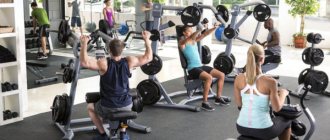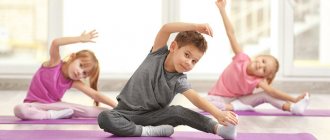Parents are always puzzled by the well-being of their child and try to give him the best so that the child grows up healthy and self-confident.
In the modern world, more and more attention is paid to children's fitness, but many confuse this concept with sections or ordinary physical education. This is fundamentally the wrong approach; today we will look in detail at what children’s fitness is and why your child needs it.
What is children's fitness?
First, you need to understand that this is a special exercise program that has nothing to do with physical education lessons and physiological inclinations are not important here, as when visiting sports sections.
Children's fitness clubs have already been opened in every major city; sometimes they are combined with a gym where parents train, but classes for children are conducted by a trainer specializing in working with children.
This is a very important point, because working with children requires a special approach:
- Psychological (somewhat includes the educational process);
- Physiological characteristics of a growing organism;
- Anatomy.
Children's fitness classes are conducted on a voluntary basis and are not divided according to the child's abilities.
Speaking about fitness for children, we can characterize it as sports activities that include several key elements of dance, gymnastics, yoga, aerobics and even sometimes martial arts.
“Junior” fitness program for children from 7 to 10 years old.
Gymnastics
A system of specially selected exercises used to improve health, harmonious physical development and improve a person’s motor abilities, agility strength, speed of movement and endurance.
Acrobatics
The exercise strengthens muscles, develops flexibility, coordination, and balance. Some exercises require working in pairs. This teaches children to work as a team.
Yoga
Study of dynamic complexes. Gymnastics for the eyes, spine, breathing exercises.
Aikido
Training in martial arts, striking and throwing techniques.
Judo
A lesson aimed at developing physical qualities and teaching self-defense techniques.
Karate
Ancient Japanese martial arts. During the lesson, children acquire self-defense and attack skills.
Fit-Aqua
Swimming training, improving swimming technique. A lesson for those who already know how to float on the water.
Fuete
Swimming training, improving swimming technique. Lesson for children who know how to float.
Arabesque
Rhythmic gymnastics lesson. Develops flexibility, plasticity, coordination. Training in working with a ball, ribbon, skipping rope and hoop.
City of masters
A creative studio where children are taught to perceive art through their own visual activities. During the lesson, the child is engaged in drawing, modeling and origami.
Types of fitness for the little ones
Classes are held not only in special clubs, but also often on the basis of dance schools or sports sections. In order to interest your child in visiting the center, you can invite him to independently choose the direction of training that suits him best.
Children's fitness programs are compiled depending on the type:
The most popular is children's fitness in the pool; there are even special “infant swimming” programs;
Children's yoga is ideal for a hyperactive child;
If your child has flat feet, then ask the children's fitness center about the BABY TOP program;
STEP BY STEP has a good effect on the development of motor skills, and helps to activate thought processes by working with the tops and fingers, where many nerve endings are concentrated.
For parents who want to combine children's fitness with mental work, in order to captivate the child as much as possible, the “Logo-aerobics” type is suitable; when performing exercises, the emphasis is on speech development. This is a rather complex subspecies, and before you send your child to such training, watch a video of children's fitness logo aerobics on the Internet.
Elements of a training program
Given the importance of good lifting form and technique, the main variables are exercise type, weight selection, repetitions, and sets of exercises. Below is an example of dumbbell lifting
- Before training, make sure you take in enough food and fluid, preferably containing carbohydrates.
- First, warm up. This may include jogging or jogging in place and light stretching.
- Demonstrate proper form and technique. For example, when lifting a dumbbell, the weight should be light enough that other parts of the body are not forced into the movement to lift the weight.
- Choose a weight that allows for at least 12 repetitions and preferably 15. This keeps the weight light enough to not place undue stress on joints and developing cartilage and bone, which is one potential risk area for weight training in children.
- Two sets of each exercise is probably sufficient for young children.
- Perform six to ten exercises depending on age, fitness and maturity. The amount of exercise and weight can be gradually increased as the child gets older or grows.
- Supervision to the maximum extent possible. Parents should take some responsibility to learn a few basics of strength training so they know what's right.
- Cool down with stretches and gentle exercises.
- Two classes every week are enough - three maximum. Children and teenagers should have at least one day between workouts
- Make your workout fun, perhaps with some music. Boredom sets in quickly in younger children and can lead to careless behavior.
At what age can you start children's fitness classes?
Due to the characteristics of a growing body, fitness aerobics classes for children have a number of age restrictions:
For children under 5 years of age, two visits lasting no more than 30 minutes are recommended;
The next age group is designed for children from 5 to 10 years old, there is a higher load. Three lessons per week of up to 40 minutes are allowed;
Children over 11 years old can do training for 40 minutes.
Water aerobics for children, as a rule, lasts up to 30 minutes, but the active time does not exceed 10.
In order to track your child's physical activity, you can purchase a children's fitness watch.
Fitness exercises for children
Children's fitness, like adults', includes a similar set of exercises. These are three parts: preparatory - warm-up, main and final - stretching.
Part 1. Warm-up
There are no better warm-up exercises than walking, running and jumping. This part lasts 10 to 15 minutes.
At first, the child should walk slowly for 1 to 3 minutes. Sometimes they alternate between walking and walking on heels and toes.
Then the child should start jogging in place for 1 to 3 minutes. Sometimes they alternate between running, in which the knees are raised high, and running with the shins overlapping.
After running, you should invite the child to jump in place on two legs, then on each in turn. When performing this exercise, your hands should be kept on your belt.
Part 2. Main part
The main part of the classes lasts at least 20 minutes and consists of active exercises.
No. 1 - “Stretch”
In the starting position, the child stands straight, with his legs slightly apart and his arms down along his body. The baby raises his hands up, places them shoulder-width apart, with his fingers apart, then stands on his toes, stretches and inhales. Then he relaxes the muscles, returns to the starting position and exhales. Repeated 4 to 5 times.
No. 2 - “Chopping wood”
In the starting position, the child stands straight, with his legs slightly apart, his arms raised up, and his palms clasped. Exhaling, the child lowers his hands down, imitating chopping wood and saying “uh.” Repeat at least 10 times.
No. 3 - “Turns”
In the starting position, the child stands straight, his feet are shoulder-width apart, and he holds his hands on his belt. Then he turns his upper body in one direction, then turns back, again - but now in a different direction. Repeat 8 to 10 times.
No. 4 - “Squats” In the starting position, the child stands straight, keeping his legs together. He slowly squats, holding his hands in front of him, exhales at the same time, quickly straightens up, and returns to his original stance. Perform 5 – 6 times.
No. 5 - “Waving your arms”
In the starting position, the child stands straight, keeps his legs straight, and his arms are spread to the sides. The child twists his arms back and forth at his shoulders for about two minutes, repeats the movements again, but with his arms bent at the elbows.
No. 6 - “Twist your head”
The child in the starting position stands straight, with his arms slightly apart, his hands on his belt. He turns his head in one direction in a circle three times, then in the other.
Benefits of Fitness for Children
Considering that fitness classes for a child are a specially designed program that takes into account the age and physiological development of the child, we can say that this is a unique training that your child needs not only for activity, but also for development at a certain stage.
The benefits include the fact that your child will communicate in a group of his peers, which will help establish communication ties in society. Since the classes are not graded and there is no allocation, as, for example, in sections, your child will feel confident.
In addition, sport instills discipline from childhood, which will make the child more focused and purposeful.
Another advantage of attending classes is that the programs include several areas at the same time, which will help you pay attention to the sports inclinations and disposition of your child in order to send him to professional sports in the future.
When answering the question of how much a subscription to children's fitness costs, you can reassure parents that the cost is not high, equal to about a month's visit to kindergarten.
Benefits of Strength Training for Children
Resistance exercises used in strength training improve muscle strength and endurance. This increases lean body mass and improves metabolism, which is especially beneficial for overweight children. Regular strength training is good for heart health, cholesterol levels, and strong bones. Strength training is also part of programs to reduce knee injuries in girls. This can help improve athletic performance, but more importantly, it builds a fitness habit that can last a child's entire life.
Contraindications for children to engage in fitness.
Even chronic diseases cannot be classified as strict contraindications; in this case, you just need to choose the right program that will improve the child’s health and will not harm him.
But, here you need to consult a doctor and carefully choose a trainer who has already had experience working with children with a similar disease.
Due to the huge selection of different types of children's fitness, there are no completely clear restrictions on a complete ban on classes.
The difference between children's fitness and sports sections
It is important that, unlike professional sections, there is no exhausting physical activity, and all exercises are performed easily and do not have any evaluative connotation behind them.
Psychological influence during fitness is also completely excluded and all exercises are performed in the form of a game, without passing any mandatory standards based on the results of training. Another significant difference is the fact that fitness focuses on the development of the child in general, rather than focusing on a specific sport.
As a rule, children go to such classes without feeling forced.
What exercises are necessarily included in a children's training program?
Speaking of this, you can even notice similarities with training in adults. Here, too, the training program consists of the required elements:
- Warm-up to warm up the muscles;
- Stretching;
- Direct training;
- The final stage is repetition of stretching.
When interacting with children during training, the instructor always maintains lively communication and develops in them positive qualities, kindness and interaction are the key points that are emphasized here.
Who can become a children's fitness instructor?
The children's fitness instructor course is designed to provide a training program for both completely young and inexperienced students, and for working professionals who want to improve their skills.
Mandatory elements of a competent course include several areas:
- Developmental Psychology;
- Physiology of the child's body;
- Anatomy.
The training will include practical and theoretical classes, which will help you easily integrate into working with children. Also, by giving preference to this profession, you can be sure of your demand in the labor market.
Specialists in the field of children's fitness work not only in sports clubs, but also in health and development centers, as well as kindergartens as teachers of therapeutic exercises.
You can even complete the training remotely, while still working at your permanent job.
Features of children's training
Children's training is now available in almost every sports center. The program for such classes differs significantly from the training plan for adults. Knowing the key points and features of working with the younger generation, you can avoid mistakes and inaccuracies in developing a set of exercises for children.
Training plays an important role in the development and formation of a child’s body. The activity of various body systems is directly dependent on the activity of skeletal muscles (especially important for the cardiovascular system). Especially in childhood. Physical activity stimulates metabolism, increases energy production, has a beneficial effect on the functioning of all body systems and increases its performance.
Systematic training from an early age is an excellent disease prevention. Primarily the musculoskeletal system. Namely – curvature of the spine and postural disorders. Also, children's training can prevent neuropsychic disorders (depression, fatigue, neuroses). Regular physical activity strengthens the cardiovascular system and increases the endurance of the child's body.
Be sure to check out:
Fitness for the abs at home and in the gym Fitness for beginners: competent workouts for a toned figure and healthy body Fitness at home: a sporty and toned figure Nutrition during fitness for a slim and athletic figure










